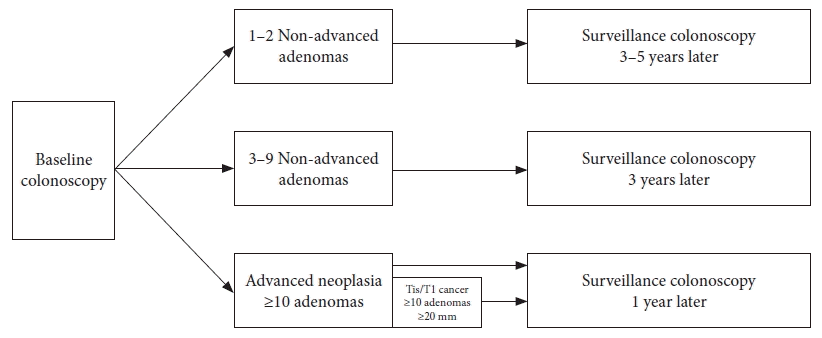1. Zauber AG, Winawer SJ, O'Brien MJ, et al. Colonoscopic polypectomy and long-term prevention of colorectal-cancer deaths. N Engl J Med. 2012; 366:687–696.
2. Atkin W, Wooldrage K, Brenner A, et al. Adenoma surveillance and colorectal cancer incidence: a retrospective, multicentre, cohort study. Lancet Oncol. 2017; 18:823–834.
3. Tran AH, Man Ngor EW, Wu BU. Surveillance colonoscopy in elderly patients: a retrospective cohort study. JAMA Intern Med. 2014; 174:1675–1682.
4. Sekiguchi M, Igarashi A, Sakamoto T, et al. Cost-effectiveness analysis of postpolypectomy colonoscopy surveillance using Japanese data. Dig Endosc. 2019; 31:40–50.
5. Winawer SJ, Zauber AG, Fletcher RH, et al. Guidelines for colonoscopy surveillance after polypectomy: a consensus update by the US Multi-Society Task Force on Colorectal Cancer and the American Cancer Society. Gastroenterology. 2006; 130:1872–1885.
6. Lieberman DA, Rex DK, Winawer SJ, et al. Guidelines for colonoscopy surveillance after screening and polypectomy: a consensus update by the US Multi-Society Task Force on Colorectal Cancer. Gastroenterology. 2012; 143:844–857.
7. Gupta S, Lieberman D, Anderson JC, et al. Recommendations for follow-up after colonoscopy and polypectomy: a consensus update by the US Multi-Society Task Force on Colorectal Cancer. Gastroenterology. 2020; 158:1131–1153.
8. Hassan C, Quintero E, Dumonceau JM, et al. Post-polypectomy colonoscopy surveillance: European Society of Gastrointestinal Endoscopy (ESGE) guideline. Endoscopy. 2013; 45:842–851.
9. Hassan C, Antonelli G, Dumonceau JM, et al. Post-polypectomy colonoscopy surveillance: European Society of Gastrointestinal Endoscopy (ESGE) guideline. Update 2020. Endoscopy. 2020; 52:687–700.
10. Brenner H, Altenhofen L, Kretschmann J, et al. Trends in adenoma detection rates during the first 10 years of the German screening colonoscopy program. Gastroenterology. 2015; 149:356–366.
11. East JE, Atkin WS, Bateman AC, et al. British Society of Gastroenterology position statement on serrated polyps in the colon and rectum. Gut. 2017; 66:1181–1196.
12. Shaukat A, Holub J, Greenwald D, et al. Variation over time and factors associated with detection rates of sessile serrated lesion across the united states: results form a national sample using the GIQuIC Registry. Am J Gastroenterol. 2021; 116:95–99.
13. Click B, Pinsky PF, Hickey T, et al. Association of colonoscopy adenoma findings with long-term colorectal cancer incidence. JAMA. 2018; 319:2021–2031.
14. He X, Hang D, Wu K, et al. Long-term risk of colorectal cancer after removal of conventional adenomas and serrated polyps. Gastroenterology. 2020; 158:852–861.
15. Lee JK, Jensen CD, Levin TR, et al. Long-term risk of colorectal cancer and related death after adenoma removal in a large, community-based population. Gastroenterology. 2020; 158:884–894.
16. Wieszczy P, Kaminski MF, Franczyk R, et al. Colorectal cancer incidence and mortality after removal of adenomas during screening colonoscopies. Gastroenterology. 2020; 158:875–883.
17. Sekiguchi M, Kakugawa Y, Matsumoto M, et al. Prevalence of serrated lesions, risk factors, and their association with synchronous advanced colorectal neoplasia in asymptomatic screened individuals. J Gastroenterol Hepatol. 2020; 35:1938–1944.
18. Foss FA, Milkins S, McGregor AH. Inter-observer variability in the histological assessment of colorectal polyps detected through the NHS Bowel Cancer Screening Programme. Histopathology. 2012; 61:47–52.
19. Matsuda T, Fujii T, Sano Y, et al. Randomised comparison of postpolypectomy surveillance intervals following a two-round baseline colonoscopy: the Japan Polyp Study Workgroup. Gut. 2020; 70:1469–1478.
20. Tanaka S, Saitoh Y, Matsuda T, et al. Evidence-based clinical practice guidelines for management of colorectal polyps. J Gastroenterol. 2015; 50:252–260.
21. Saito Y, Oka S, Kawamura T, et al. Colonoscopy screening and surveillance guidelines. Dig Endosc. 2021; 33:486–519.
22. Hotta K, Matsuda T, Tanaka K. Post-polypectomy colonoscopy surveillance in the real clinical practice: nationwide survey of 792 board certified institutions of the Japan Gastroenterological Endoscopy Society. Dig Endosc. 2020; 32:824.
23. Sekiguchi M, Otake Y, Kakugawa Y, et al. Incidence of advanced colorectal neoplasia in individuals with untreated diminutive colorectal adenomas diagnosed by magnifying image-enhanced endoscopy. Am J Gastroenterol. 2019; 114:964–973.
24. Djinbachian R, Dubé AJ, Durand M, et al. Adherence to post-polypectomy surveillance guidelines: a systematic review and meta-analysis. Endoscopy. 2019; 51:673–683.
25. Rex DK, Schoenfeld PS, Cohen J, et al. Quality indicators for colonoscopy. Gastrointest Endosc. 2015; 81:31–53.
26. Kaminski MF, Thomas-Gibson S, Bugajski M, et al. Performance measures for lower gastrointestinal endoscopy: a European Society of Gastrointestinal Endoscopy (ESGE) Quality Improvement Initiative. Endoscopy. 2017; 49:378–397.
27. Sekiguchi M, Kakugawa Y, Matsumoto M, et al. A scoring model for predicting advanced colorectal neoplasia in a screened population of asymptomatic Japanese individuals. J Gastroenterol. 2018; 53:1109–1119.
28. Kamba S, Tamai N, Saitoh I, et al. Reducing adenoma miss rate of colonoscopy assisted by artificial intelligence: a multicenter randomized controlled trial. J Gastroenterol. 2021; 56:746–757.
29. Bishay K, Causada-Calo N, Scaffidi MA, et al. Associations between endoscopist feedback and improvements in colonoscopy quality indicators: a systematic review and meta-analysis. Gastrointest Endosc. 2020; 92:1030–1040.
30. Saito Y, Kodashima S, Matsuda T, et al. Current status of diagnostic and therapeutic colonoscopy in Japan: the Japan Endoscopic Database Project. Dig Endosc. 2022; 34:144–152.





 PDF
PDF Citation
Citation Print
Print



 XML Download
XML Download